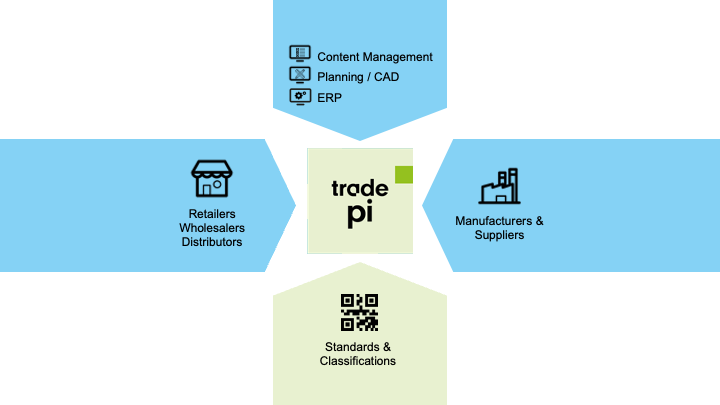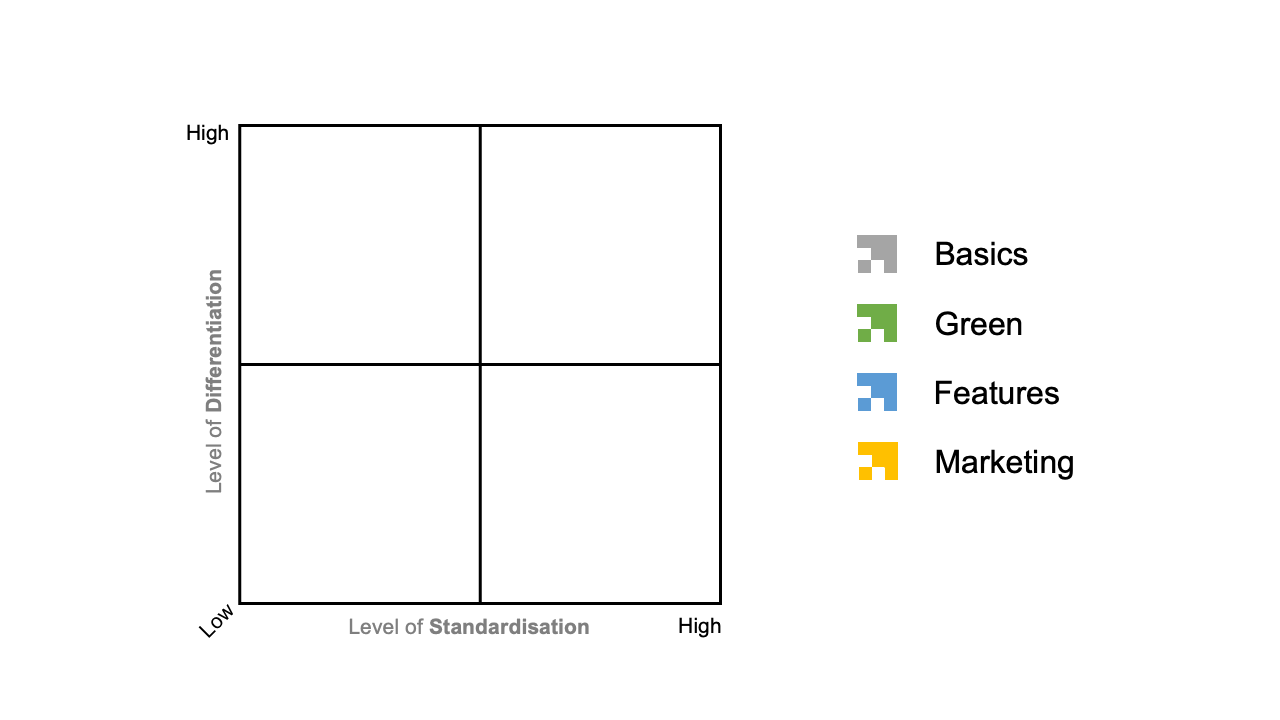4 min read
TradePI: the product information standard that will change e-commerce forever!
Donna Celeste
:
Grd 26, 2023 19:33

The TradePI standard is a collaborative effort facilitated by Tradeplace, and it is defined and supported by four key market forces to ensure it meets the broad needs of the e-commerce industry.
These market forces are:
-
Trade/Retailers/Wholesalers/Distributors: This group includes the various sales channels that bring products to market. They play a crucial role in ensuring that the product information they present to end consumers is accurate, up-to-date, and complete. By participating in the definition of the TradePI standard, they help establish the requirements for the product information that is most relevant to their operations and customer needs.
-
Manufacturers/Suppliers: As the creators and providers of products, manufacturers and suppliers are responsible for supplying the detailed product information. Their involvement in defining the TradePI standard is vital as it ensures that the data structure accommodates the depth and breadth of information they need to communicate, supporting their branding and marketing strategies.
-
Digital Partners: Content Management Systems (CMS), Kitchen Planning software providers, Enterprise Resource Planning (ERP) systems, and online marketplaces. These digital partners are instrumental in the dissemination and utilization of product information. Their input in the TradePI standard is essential for ensuring compatibility and smooth integration across various digital platforms and tools.
-
Standardisation & Classification Organisations: Entities such as eCl@ss, ETIM, IDM, and GDSN are involved in the global standardization and classification of product data. Their contribution to defining the TradePI standard guarantees that it aligns with international norms and practices, facilitating cross-border trade and interoperability among different systems and industries.

The collaborative nature of the TradePI standard ensures that it is robust, versatile, and well-suited to the dynamic and interconnected e-commerce industry. By involving these four market forces, Tradeplace ensures that the standard not only meets the diverse needs of the participants but also promotes efficiency, accuracy, and consistency in product information management across the entire supply chain.
The TradePI Standard has been registered as an official standard with International Code Designator (ICD): 0214
Trade-PI benefits for Retailers and Manufacturers
Bot retailers and manufacturers benefit from the TradePI standard. Below is a detailed description of the benefits for each group.
For Trade/Retailers:
-
Unified Structure: Retailers benefit from a single, cohesive structure for product data across all manufacturer brands, greatly simplifying the integration and management of diverse product information.
-
Complete and Correct Information: TradePI ensures that retailers receive complete and correct product details, enabling them to provide accurate information to consumers and enhance customer trust.
-
Current Information: Retailers have access to the latest product information, which is critical for maintaining accurate listings and supporting informed customer purchase decisions.
-
Cost Efficiency: The TradePI standard is available to retailers at no cost, offering them a valuable resource without additional financial burden.
-
Direct Manufacturer Contact: The standard allows for direct communication between manufacturers and retailers, streamlining the resolution of inquiries and improving cooperation.
-
Electronic Accessibility: Retailers can access product information electronically via tradeplace.com, ensuring ease of availability and efficiency in retrieving the necessary data.
-
Enhanced Filtering and Comparisons: Attributes and descriptions provided by the TradePI standard enable better filtering and comparison across brands, facilitating advanced search capabilities on websites and POS systems.
For Manufacturers/Suppliers:
-
Direct Retailer Communication: Manufacturers can communicate directly with retailers without third-party interference, fostering clearer and more efficient exchanges.
-
Control Over Information: Manufacturers maintain full control over their product information, ensuring it is used appropriately and reflects their brand accurately.
-
Complete Data Communication: TradePI enables manufacturers to communicate comprehensive product information, ensuring retailers have a full understanding of each product.
-
Brand Value Support: The standard aids in better supporting and communicating the manufacturer's brand value to the market.
-
Cross-Media Utility: Manufacturers can use the TradePI standard for various cross-media applications, enhancing the versatility of their marketing efforts.
-
Solution Versatility: TradePI provides one standard that can be applied to numerous solutions, streamlining processes for manufacturers.
-
Marketing Differentiation: The standard allows manufacturers to clearly differentiate their marketing strategies, highlighting brand-specific values and unique selling points.
-
Brand-Specific Communication: Manufacturers can effectively communicate brand-specific values, further distinguishing their products in the marketplace.
differentiation vs. standardisation
The TradePI standard allows for ample differentiation while in the same time providing the standardisation needed for effective e-commerce.
The TradePI information is split-up in 4 groups of attributes: Basics, Green, Features, and Marketing, whereas the Basics attributes are the most standardised, and the Marketing attributes allow for the most differentiation.

 Basics
Basics
These fundamental attributes provide the essential details that identify and describe a product, and they are commonly used for product listing, cataloging, and logistical purposes. They are the foundational data points that facilitate product recognition, tracking, and comparison across various systems and platforms within the retail and supply chain industries.
Examples: Brand name, GTIN (Global Trade Item Number), Article number, Voltage, Colour, Measurements
 Green
Green
These attributes are essential for providing consumers with insights into the energy performance and efficiency of appliances, which is a significant factor in purchasing decisions. Such information is also often mandated by regulatory authorities to ensure compliance with energy efficiency standards and to promote environmentally friendly consumer choices.
Examples: Energy efficiency class, Energy consumption, EPREL (European Product Database for Energy Labelling), Noise levels, and Product fiches
 Features
Features
These attributes detail the specific functions, capabilities, and customization options of a product, providing consumers with information on what the product can do, how it performs, and the various ways it can be used or adjusted to suit their needs. These features often serve as key differentiators between products and can significantly influence purchasing decisions by highlighting the unique aspects and technological innovations of each item.
Examples: Wash options, Materials, Additional Options, Special programmes,
 Marketing
Marketing
These are the visual and descriptive assets used to present and market the product to consumers, emphasizing its appearance, key features, and unique advantages. They play a critical role in branding, advertising, and visually communicating the value proposition of the product to potential buyers, both in-store and online.
Examples: Logos, Product Images, Panel Images, Measurement drawings, Unique Selling Points (USPs)
TradePI: join the change !
In an industry where efficiency and accuracy are paramount, the TradePI standard emerges as a beacon of innovation and collaboration. Retailers and manufacturers alike are called to embrace this transformative standard, which has been meticulously crafted with the input of key market forces to address the unique challenges and demands of e-commerce.
For retailers, TradePI is the golden key to a treasure trove of streamlined processes, ensuring that they can present the most current and accurate product information to their customers, thereby fostering trust and satisfaction.
For manufacturers, it is a platform that amplifies their voice, allowing them to convey the full scope of their product information directly to those who bring it to the marketplace.
By adopting the TradePI standard, both retailers and manufacturers gain a competitive edge. It allows them to not only meet but exceed industry standards, offering consumers unparalleled access to detailed, reliable, and eco-conscious product information. This commitment to excellence and sustainability is what will define the leaders of tomorrow's e-commerce landscape.
As we stand at the crossroads of differentiation and standardization, the TradePI standard proves that you can indeed have the best of both worlds. It offers a foundation for consistency while providing ample room for brands to showcase their unique strengths and values.
We encourage all retailers and manufacturers to seize this opportunity to elevate their operations and join a community of forward-thinking businesses. Download the TradePI standard today at www.tradeplace.com/TradePI and be part of the movement setting new benchmarks for product information management in the digital age. Together, let's build a future where every link in the supply chain benefits from transparency, innovation, and sustainability.

